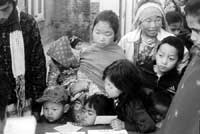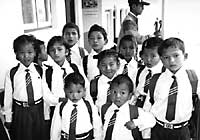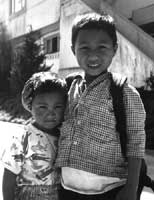|
|
||||
|
Help in Action: Victories & challenges in KathmanduValley |
||||
|
First day at school Krishna & Baboo |
by Sharon Dawson Nepal is famous for being home to eight out of ten of the world's highest mountains but a less well known fact is that Nepal is one of the poorest countries in the world. 90% of the population survives from subsistance farming and the income per capita is US$ 130 per year. Many people are forced every year to leave their mountain villages and move into the cities to search for work in carpet factories. Although child labour is banned by the Government of Nepal, it is not unusual to meet children who have been brought to the city from their villages, to become unpaid servants, babysitters, dish washers ... simply because their parents are unable to feed and educate them. Nepal lacks basic health care facilities - with a population of over 19 million, the country has only 2,000 working doctors - the infant mortality rate is one of the highest in the world and diseases such as TB and meningitis are prevalent. It also lacks basic educational facilities (especially in rural areas) and many people are unable to afford the admission fees, uniforms and school materials. Ensuring that aid is distributed to those who really need it and utilised in a correct way, is the biggest challenge facing all agencies who decide to work in Nepal. From the very beginning, when «Help in Action» decided to extend its sponsorship programme to include Nepalese children, it was clear that administering the project would present many challenges, but as the recent trip to Nepal (Feb/Mar 2000) demonstrated it is proving to be the most satisfying and rewarding work. There are presently 280 Nepalese children sponsored through the Association. During our two month stay in Nepal, we met with almost all the sponsored children and their families. Together, we visited all the schools to check that the children have attended regularly and that all school fees were paid up to date. Without exception, all children did attend school regularly, only one family was behind with school payments and with the exception of two families all the sponsored children seem to be kept cleaner and better clothed. Also to our great pleasure the principals in three of the local schools commented on the fact that the parents of sponsored children are taking more interest in their education and development, and that the children themselves generally work harder. As we develop closer relationships with the local schools we are also negotiating - in true Nepalese fashion - discounts and free places, allowing us to extend help to those still waiting for a sponsor. During the monthly distribution of money - for those families needing extra help with daily living expenses - we set up office on the lawn of the Healing Centre Clinic. We offered all the children (around 60) crayons, exercise books, sweets, and of course money - all the children excitedly opted for the crayons showing no interest whatsoever in the money! The two months were punctuated with memorable moments, but in particular the joy and excitement of the newly sponsored children was contagious as we rushed around Kathmandu with them filling in school admittance forms, buying school uniforms, shoes, bags and books... in time to meet the March 1st school entrance date! We were also particularly touched by the case of two small children, Krishna and Baboo, who were recently abandoned by their mother. Owing to the generosity of the staff and visitors of the Healing Centre Guesthouse we were able to collect enough money to admit them into a nearby boarding school. This particular case clearly demonstrates once again the need for an emergency fund, which would give us the confidence to deal with such situations immediately. We are now searching for permanant sponsors for Krishna and Baboo. Our extended family in Nepal is growing everyday - with thanks to your help and support - but there are still many children waiting for their chance.
If you would like to help contact «Help in
Action»: |
|||
|
|
||||




